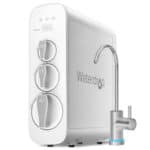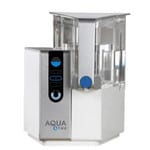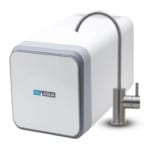Reverse osmosis filtration systems are the gold standard for protection against the thousands of contaminants that could be lurking in your water, but older models have a reputation for being bulky, expensive and costly to maintain.
Expert Picks:
We know that finding the perfect reverse osmosis water system is no picnic. Deciphering technical specifications and sorting the through the hype is exhausting, so relax — we’ve scoured the market to bring you the 7 best models plus a buying guide to help you get the most out of our review.
Let’s get started…
#1. WaterDrop -G3P800 RO System
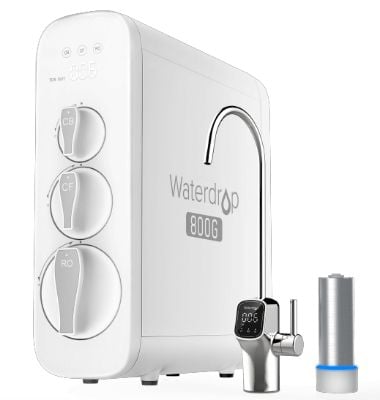
This is hands down our favorite choice, the WaterDrop RO water filtration system.
Waterdrop took the problems of old and designed a sleek compact design that can be installed in 30 mins or less without the need of a plumber.
Fill a gallon jug in less than 2 minutes…
Features:
- High-Flow 800 GPD
- UV filtration
- Installs in 30 minutes or less
- NSF/ANSI 58 certified for TDS Reduction
- 3:1 water waste ratio
- Tankless design for added storage room
Use Coupon code QWL-10OOF
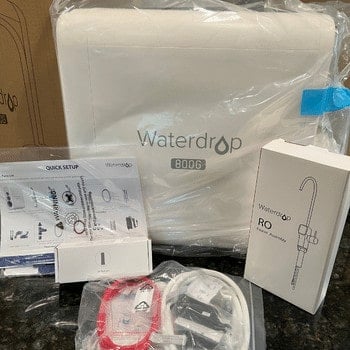
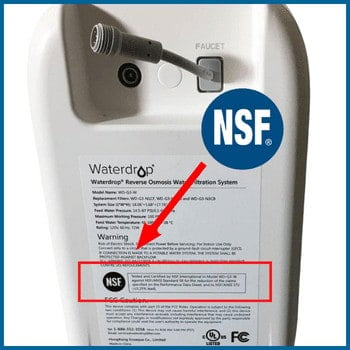
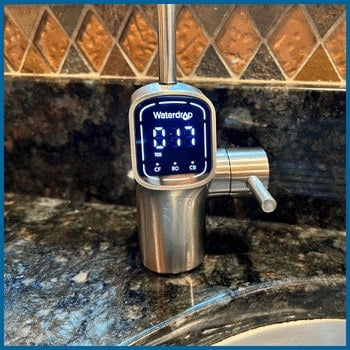
Filtered on the left vs non-filtered on the right
Great For: This is the perfect solution for 99% of families out there when it comes to cost vs value.
Not Ideal for: Those that get their water from a well.
Pros
- Waterdrop RO system reduces water waste by 300% over traditional and current units sold online.
- It also has a safe shutdown feature for when you have been running water for longer than 30 mins.
- Filter life is 6 months (sediment/carbon block) & 12 months (Activated carbon) & 24 months (RO Membrane).
- Functionality – This system can be hooked up to your refrigerator with an add-on adapter.
- Minimal waste water – For every 3 gallons of water produced, this system will waste 1 gallon — this is pretty good in comparison to other RO systems.
- Contaminant Removal – The G3P800 is capable of removing over 1000 contaminants that are larger than 0.0001 microns.
- Built-in UV light – If bacteria & viruses worry you, fear not. Waterdrop’s UV filtration will zap 99.9% in its tracks and lasts nearly 50 years.
- Reduces: TDS, limescale, heavy metals, bacteria, viruses, and more than 1,000 other harmful contaminants.
- Filters: To help extend the life of their filters, Waterdrop automatically initiates flushing of the system so you don’t have to worry about it.
- 7-stage filtration process: Removes chlorine, taste and odor, sand, rust, solids, and other impurities.
Cons
- Slightly costlier than competitors
- Three filters to change when needed
WaterDrop Product Updates:
- Waterdrop now includes a digital faucet to display TDS and filter life all while your pour a glass of water.
#2. NU Aqua Tankless Reverse osmosis 600GPD System
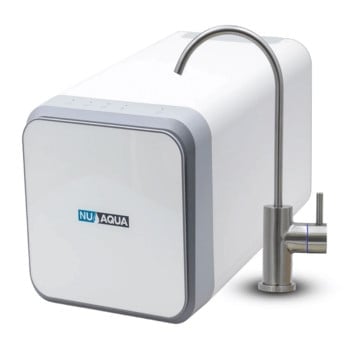
This is another favorite of ours and not because of the price, but the reliability and convenience of space in under the sink.
With dozens of positive verified reviews, NU aqua gives you 4-stages of water filtration that will remove up 99% of the contaminants we don’t need in our drinking water.
- High-Flow 600 GPD
- Low water pressure booster
- Tool-less quick filter changes
- Filter light change indicator
- 99% of contaminants removed
- 180 satisfaction guarantee
- Compact Tankless design
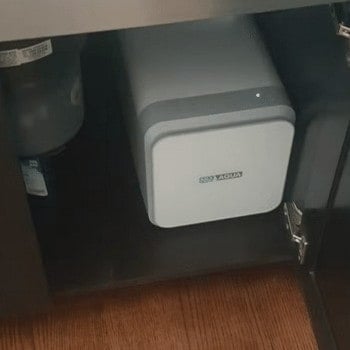
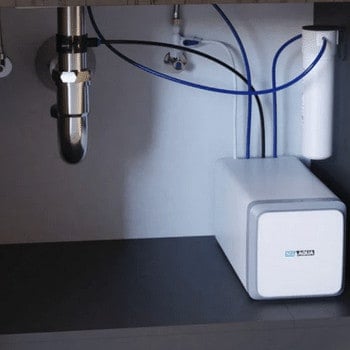
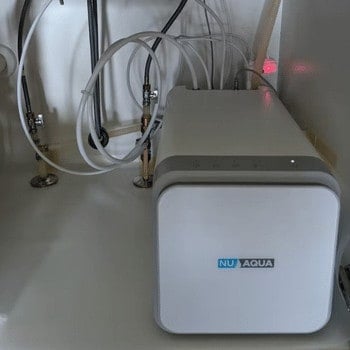
Great For: This system is cheaper than WaterDrop and provides similar water quality for a compact reverse osmosis system, I think you’ll like it.
Pros
- What I love about this system is the fact that I don’t NEED any hand tools to make a filter change – the only thing you have to do is lift the front cover and twist out the old filter to replace –Pretty simple in my book!
- Another positive feature I love is the fact it comes with a water pressure booster – nothing worse than waiting to pour a glass of water especially if you have young kiddos.
- This system has 4-stages of filtration: granular & activated carbon, and a semi-permeable membrane.
- The filters last for 6 months on the PP/CB filter, the GAC will last 12 months and the RO membrane will get you 36 months.
- NU Aqua’s compact tankless filtering capabilites can tackle a broad range of contaminants ranging from: VOC’s, sediment, heavy metals, rust, organic materials, and chlorine.
- The system has a better than average pure water to waste ratio of 2:1 above traditional RO systems.
- NU Aqua comes with a 180 day satisfaction guarantee if you don’t like this system and also comes with a 5-year warranty if you decide to keep it – so you really have nothing to lose .
- However, the Nu-Aqua system is over a 100.00 cheaper and does have a better flow rate but isn’t a space saver like Waterdrop is – you can read our Waterdrop WE-G3 Review here.
- NU Aqua does offer an alkaline filter adapter for those in need.
Cons
- Installation can be a pain for some setups
NU Aqua Product Updates:
- NU Aqua now offers a lifetime warranty on this system with a subscription to their filter replacement service. You will save an extra 10% by joining and you don’t have to think about ordering new filters at the last minute –they just show up on time.
#3. iSpring RCS5T Tankless Reverse Osmosis Water Filter — Perfect for Large Families
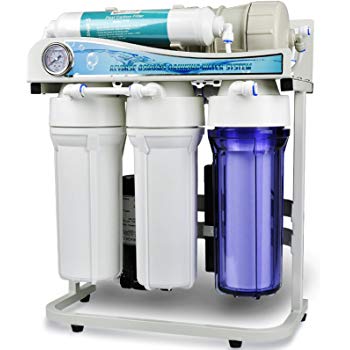
iSpring’s RCS5T isn’t your typical residential RO water filter — it’s designed to meet the needs of small business including restaurants.
Features
- High-capacity system
- Tankless design saves space
- 0.0001 micron membrane rating
- 1:1 waste to clean water ratio means less water use
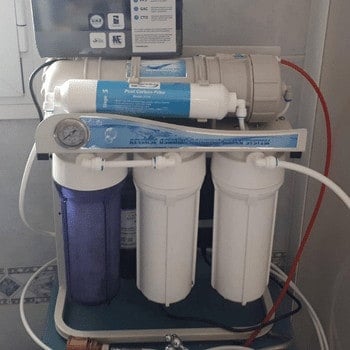
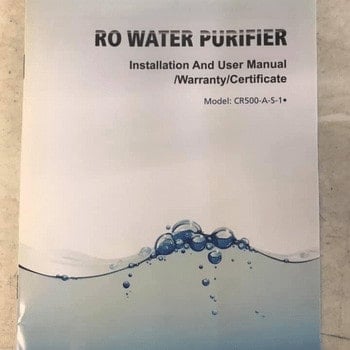
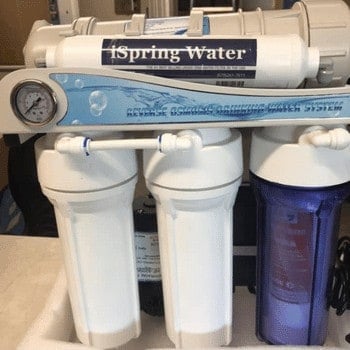
Ideal for: Those looking for a traditional compact reverse osmosis system that’s reliable and affordable.
Pros
- Five stages of filtration remove 99-percent of more than a 1000 troublesome contaminants down to 0.0001 microns.
- Ispring also offers up a solid patented dual-flow membrane and powerful booster pump, it provides large volumes of pure water without the need for a storage tank.
- A built-in pressure gauge allows you to monitor the system’s performance without guesswork while the tankless design makes it easy to install in limited space.
- With a 500-gallon per day maximum capacity, this is one of the few true on-demand, whole-home filtration systems that won’t leave a large family without enough filtered water for all of its needs.
- This system can filter both city and well water.
- For well water, the system’s 0.0001 micron rating removes nearly all pathogens.
- The RO membrane should be replaced every 1500 gallons. Pre- and post-filters last six months.
- Most homeowners can install the Ispring RO system with basic know-how in a few hours.
- This unit has exceptional filtration capability, and its size makes it convenient to install.
- Capacity and flow rate are affected by many factors, so practically speaking, you might not get the 500-gallons per day output and flawless flow rate his system can produce under “ideal” condition, but since most filter makers advertise their systems similarly — it’s still comparing apples to apples.
Cons
- Limited one-year warranty
- Optional tank required for optimal performance
Ispring RCS5T Product Updates:
- Nothing to report, yet.
#4. Home Master TMHP Undersink Reverse Osmosis Water Filter System
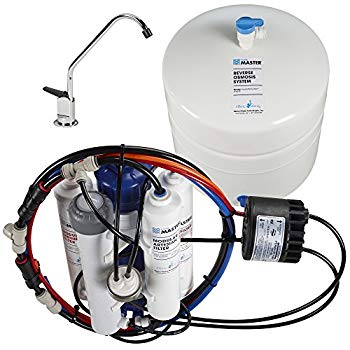
Home Master RO calls the TMHP a “better” filter because it solves a common problem with RO systems — that they remove healthy minerals like calcium and magnesium.
Features
UV light kills pathogens filtration alone could miss
Permeate pump saves water
Easy filter changes
Five-year warranty
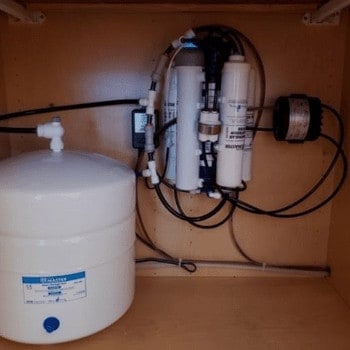
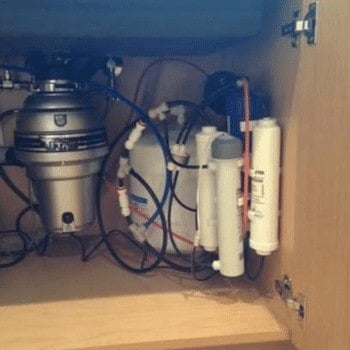
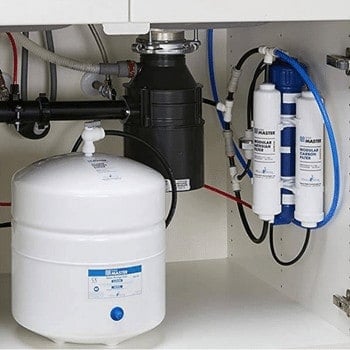
Ideal for: For anyone on a private well looking for a great performing system that’s reliable and functional.
Pros
- All RO systems remove some minerals, but Home Master’s Full Contact remineralization technology adds them back in, and that’s better for your health and the life of your RO system’s storage tank.
- The TMHP will remove all of the contaminants you would expect, and with a UV light, it’s especially effective against pathogens — a must for well water.
- Over-sized fittings and high-flow components mean a faster flow rate, and the integrated permeate pump reduces wastewater production by up to 80-percent.
- I like this system. Despite the tank, it’s compact, and installation is a cinch.
- It looks more complicated than it is when you open the box, but the tubing is all color-coded, and the instructions are well-written.
- As for filtering capability, its micron rating isn’t as high as iSpring’s RCS5T, but it’s close, and with the addition of the UV light, I consider them equal.
- Filters are changed yearly as a set — there’s no complicated maintenance schedule.
- While you won’t get quite as fast a flow at the faucet as with the iSpring, it’s plenty brisk enough for providing drinking and cooking water.
- Filters should be changed every 2,000 gallons or at least once per year.
- The tubing and plastic components are BPA-free.
- Best of all — Home Master backs it with a five-year warranty.
Cons
- Storage tank may be a tight fit under sinks with disposals.
Home Master TMHP Product Updates:
- Improved Non-electric permeate pump and reduced TDS Creep
#5. APEC Water Systems ULTIMATE RO-PERM Reverse Osmosis Drinking Water Filter System
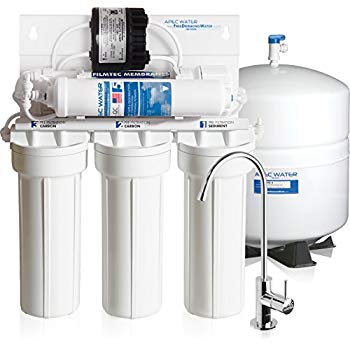
Most RO filters need relatively high water pressure to operate, so if your home’s water flow is low, you’ve been out of luck until now.
APEC’s ULTIMATE RO-PERM filtration system comes in two models for different levels of pressure.
Features
- Capable filtration for well or city water
- 36-90 Gallon Per Day (GPD) capacity
- Warranty includes lifetime support
- Dispensing faucet has above average styling
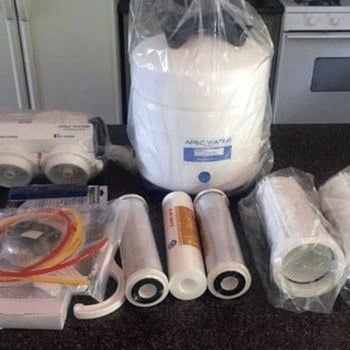
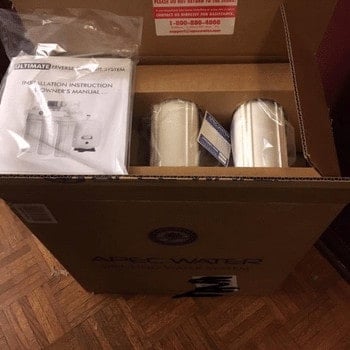
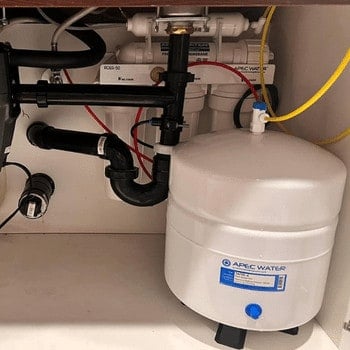
Ideal For: This is a great system for homes with low water pressure, and for anyone looking to eliminate harmful contaminants efficiently for a great price.
Pros
- Five-stage filtration is guaranteed to remove 99-percent of contaminants including arsenic, lead and harmful microorganisms.
- Its super-capacity filters require replacement less often than other brands.
- It comes equipped with a permeate pump that saves energy and helps the storage tank fill faster — so you’ll never run out of clean water.
- It’s assembled in the U.S. A. and comes with a one-year satisfaction guarantee.
- This system will safely reduce TDS.
- The system is pretty simple to install from our own experience.
- The water to waste ratio is 3:1
- This system’s filtration capability is similar to both the iSpring RCS5T and Home Master’s TMHP HydroPerfection.
- Capacity and flow rate are comparable to the TMHP.
- The big advantage of this system is its ability to operate under low pressure. In some parts of the country, that’s gold.
Cons
- Permeate pump is noisier than most
- The other difference is the lack of remineralization technology — a disadvantage for health, but an advantage if you don’t have a water softener and want to get rid of at least some minerals.
- For a few dollars more, I prefer the THMP Hydroperfection under most circumstances.
Apec Ultimate Perm RO Product Updates:
- Nothing new, yet.
#6. iSpring RCC7AK-UV Deluxe Under Sink 7-Stage Reverse Osmosis System
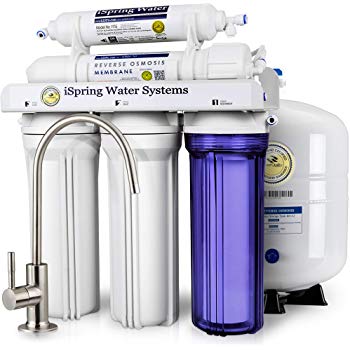
iSpring 7-stage put the filtration capability of its whole-home RCS5T system in a smaller point-of-use system.
Seven stages of filtration remove up to 99-percent of unwanted contaminants, and the UV light — one of the strongest in the industry — adds an extra layer of protection again pathogens.
Features
- 75 GPD capacity
- Long-lasting filters
- Remineralization filter
- Straightforward DIY installation
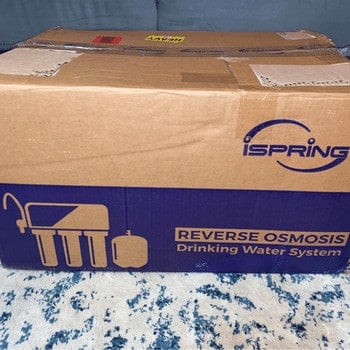
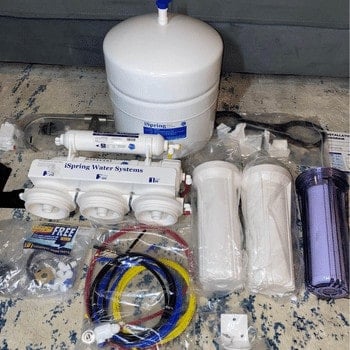

Pros
- An alkaline remineralization filter puts the sodium, magnesium, calcium and potassium stripped out of water by the RO membrane back in — restoring a healthy balance.
- Water flow is brisk for a reverse osmosis system, and with no moving parts, it operates silently.
- Long-lasting filters keep the cost of ownership down, and it’s backed by a one-year warranty.
- The first three pre-filters should be changed every six months. The others last a year.
- The UV light is strong — 11 watts instead of the standard six.
- It also turns off via a sensor switch when water isn’t running, extending both the life of the bulb and improving its efficacy.
- The waste water ratio is two gallons of waste water are produced for each gallon filtered.
- iSpring put a lot of thought into this system. From easy homeowner installation to top quality filters, there’s a lot to like here.
- The UV light is exceptionally well-designed. It’s hard to believe most models have bulbs that are on continuously.
- I wish it had a permeate filter for efficiency, but as RO systems go, it’s among the most efficient without one, and it does run quietly — a big plus in some homes.
- Like iSpring’s other products, this filter is so well made I’d be happy to have it my kitchen, but if Home Master can offer a five-year warranty on their TMHP HydroPerfection, I’d like to see iSpring do the same with this system.
Cons
- Short one-year warranty
- No permeate pump
Ispring RCC7AK Product Updates:
- Nothing new, yet.
#7. Express Water Alkaline Reverse Osmosis Water Filtration System
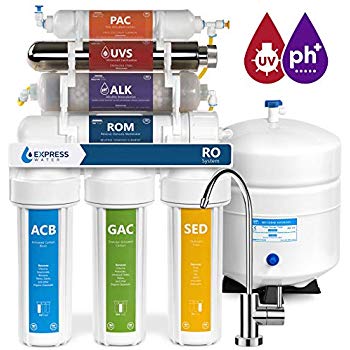
Express RO Water says this system delivers the healthiest, freshest-tasting water on Earth — you be the judge.
Features
- Low-cost of ownership
- Easiest installation in it’s class
- Integrated auto shut-off valve
- Makes water alkaline
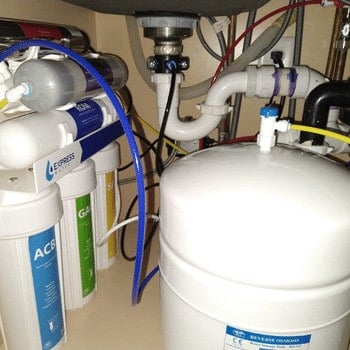
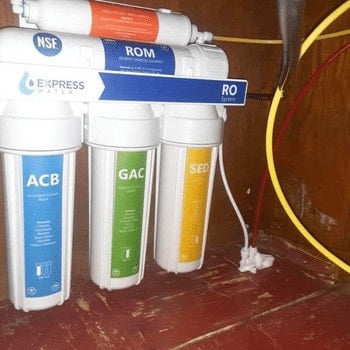
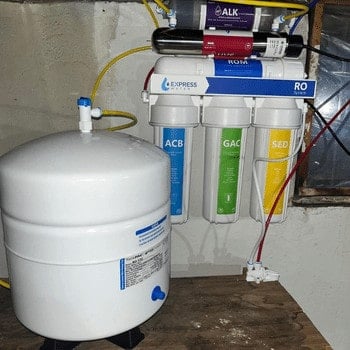
Great for: Anyone looking for a reverse osmosis system that has long-lasting filters and is capable of removing tough contaminants.
Pros
- It starts with five-stages of filtration that remove up to 99.99-percent of chlorine, lead, fluoride, arsenic and more — the highest reduction level in the industry.
- Next, five additional filters add beneficial minerals in much the same way a natural spring does, plus antioxidants and extra oxygen for an energizing experience in every glass.
- Installation couldn’t be easier, and its 50 GPD total output is impressive given its size.
- Long-lasting filters plus a surprisingly low initial price keep the long-term cost of ownership down.
- I don’t know if I need extra oxygen or antioxidants in my water, but for the price of this system, I’m thrilled with its filtration capability.
- It doesn’t come with permeate pump, so the waste to clean water ratio is a little high — three to five gallons — but it runs quietly, and if water costs aren’t going to break the bank, it’s not the biggest deal.
- Hands down, this is the perfect system for anyone worried about do-it-yourself installation — it couldn’t be any easier.
- This system safely removes PFOA’S
- The filters will last 6 months and the RO membrane one year.
- The alkalinity enhancer cartridge can be bypassed.
- It’s also an excellent pick for anyone who wants the security of superb filtration and alkaline water, and with one of the lowest initial prices and low maintenance costs, it’s perfect if you need a high-quality filter on a budget.
Cons
- Nothing worth mentioning 🙂
Express Water RO System Product Updates:
- Deluxe chrome faucet is now included
Compare All 7 Reverse Osmosis Systems
(Mobile users: Swipe to scroll) Compare Brands & Models
Compare Brands & Models
|
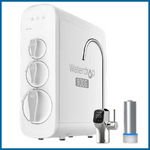 #1 WaterDrop G3P800 RO System
#1 WaterDrop G3P800 RO System |
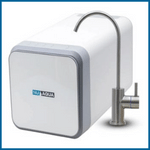 #2 NU Aqua RO System 600 GPD
#2 NU Aqua RO System 600 GPD |
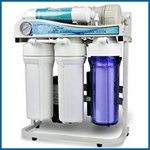 #3 Ispring RCS5T RO System
#3 Ispring RCS5T RO System |
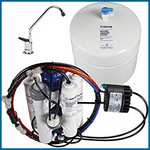 #4 Home Master TMHP RO #4 Home Master TMHP RO |
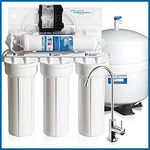 #5 APEC Ultimate RO-PERM
#5 APEC Ultimate RO-PERM |
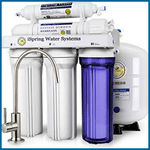 #6 Ispring RCC7AK-UV System
#6 Ispring RCC7AK-UV System |
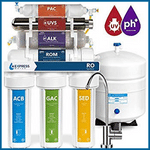 #7 Express Water Alkaline System
#7 Express Water Alkaline System |
|---|---|---|---|---|---|---|---|
| Rating | 5/5 | 5/5 | 4.5/5 | 4.5/5 | 4.5/5 | 4.5/5 | 4.5/5 |
| Price | $$$ | $$$ | $$ | $$ | $ | $ | $$ |
| Waste Ratio | 3:1 | 2:1 | 3:1 | 1:1 | 1:3 | 3:1 | 1:3 |
| Filtration Stages | 7 | 4 | 5 | 7 | 7 | 7 | 10 |
| Water Production | 800 GPD | 600 GPD | 500 GPD | 50 GPD | 90 GPD | 75 GPD | 50 GPD |
| UV | ✔️ | ❌ | ✔️ | ❌ | ❌ | ✔️ | ✔️ |
| Remineralization | ✔️ | ✔️ | ✔️ | ✔️ | ❌ | ✔️ | ✔️ |
| Certifications | NSF/ANSI 372, 58 certified | n/a | n/a | NSF 51 | n/a | NSF 58 certified | NSF/ANSI Standards 42, 58, 401 and EPA 524.2 |
| Technology | Digital | Digital | ❌ | ❌ | ❌ | ❌ | ❌ |
| Annual Cost | ~$170 | ~$160 | ~$120 | ~$125 | ~$100 | ~$100 | ~$130 |
| Warranty | 1 year | 5 Years | 1 year limited | 5 Year Limited | 1 Year | 1 Year limited | 1 Year limited |
How We Chose
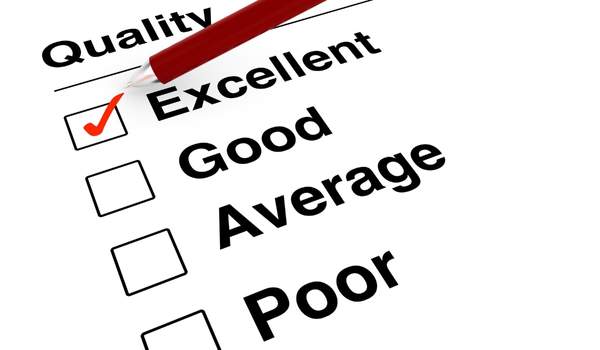
Diving into the world of reverse osmosis (RO) water filters, we rolled up our sleeves and splashed into an ocean of options. We focused on these indispensable elements in our search to find the crème de la crème of RO systems:
- Filtration Efficiency: Prioritization was given to systems boasting high removal rates of contaminants, ensuring crystal clear water devoid of unwanted particles and impurities.
- Water Waste Reduction: We favored systems with low water waste ratios, aligning with environmental sustainability and reducing utility bills.
- Installation Simplicity: A smooth sailing installation process was crucial, ensuring even the most non-techy individuals can set up their systems with ease and confidence.
- Maintenance Ease: Systems earning our nod were those requiring minimal maintenance, ensuring uninterrupted, quality water supply with little hassle.
- Durability and Reliability: We sought systems built to last, backed by commendable warranties and excellent customer reviews to affirm longevity and performance.
- Cost-Effectiveness: A keen eye was kept on ensuring maximum value for money, ensuring high-quality water purification without breaking the bank.
- Certifications: Like a seal of excellence, we looked for systems holding certifications from trusted organizations, assuring adherence to quality and safety standards.
And yes, the real-world user experiences were the cherry on top, ensuring the chosen systems stand up to the test of time and daily use, safeguarding your water supply with unwavering reliability.
Buyer’s Guide
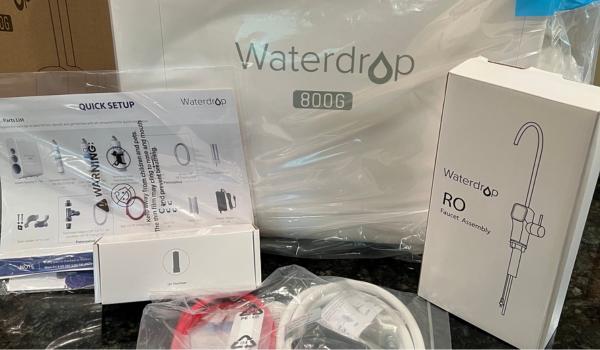
As you sail on the quest for pristine water, reverse osmosis is your trusty compass, guiding you to pure, refreshing water. It’s not just about quenching thirst, it’s about ensuring the water you consume is free of contaminants, minerals, and other unwelcome guests. But how to select your ideal RO system? Let’s embark on this adventure together!
Why Choose Reverse Osmosis?
Navigating the waters of water purification, RO emerges as a stalwart guardian, banishing contaminants like salts, chlorine, and lead, ensuring every drop you consume is pure and safe.
- Comprehensive Contaminant Removal: RO systems effectively remove up to 99% of common contaminants, including heavy metals, bacteria, and dissolved solids.
- Improved Taste and Odor: By filtering out chlorine, sediment, and other impurities, RO systems deliver crisp, clean water that tastes great.
- Health Benefits: Removing harmful chemicals like lead, arsenic, and nitrates contributes to better overall health.
Before diving into your RO system purchase, let’s chat about what really matters: health benefits, environmental impact, and those all-important certifications. This isn’t just about clean water—it’s about making smart, sustainable choices that keep you and the planet in good shape.
Health Benefits of RO Water

When you’re filtering water, it’s not just about taking things out—it’s about what you’re leaving behind. RO water isn’t just cleaner; it’s better for you. Let’s break down why that matters:
- Cleaner Water, Healthier You: RO systems are champs at removing nasty stuff like lead, arsenic, and nitrates. This means you’re not just drinking water—you’re drinking peace of mind.
- Added Perks: Some systems even toss minerals back into your water. So, you get the clean stuff plus a health boost. Win-win!
Environmental Impact and Sustainability
Water purification is crucial, but doing it in a way that’s gentle on the environment is just as important. Modern RO systems have stepped up their game to be more eco-friendly, and here’s how:
- Eco-Warrior Approved: Modern RO systems have cut down on water waste, which is great for the planet and your wallet.
- Recycling? Yes, Please: Some brands will take back your used filters. Less waste, more good vibes.
- Look for Efficiency: Pick a system that’s easy on water use and built with sustainable parts. Every drop counts, right?
Certifications and Standards
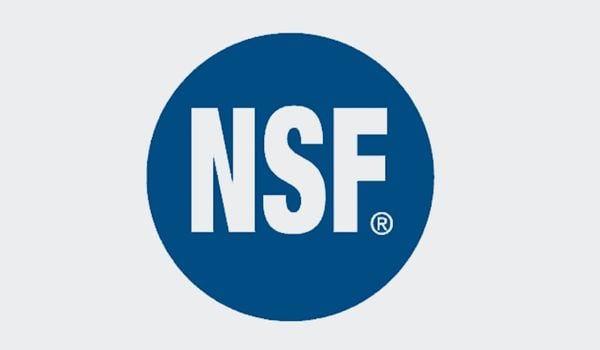
Not all RO systems are created equal. Certifications from recognized bodies are the gold stars that tell you a system is trustworthy and safe. Here’s why you should care:
- Trust but Verify: Certifications like NSF/ANSI 58 mean your RO system isn’t just a pretty face. It’s been tested for safety and performance.
- Why It Matters: These stamps of approval ensure your system does what it says—cleans water and lasts long without cutting corners.
Making the right choice isn’t just about clean water—it’s about choosing a system that’s kind to your health and the environment.
Types of RO Systems
- Under-Sink RO Systems: A compact sentinel guarding your kitchen’s water supply, ensuring every drop from the tap is pure perfection.
- Countertop RO Systems: Perfect for the space-conscious, these systems perch on your counter, purifying your water without demanding much real estate.
- Whole-House RO Systems: For those desiring comprehensive coverage, these systems shield your entire household water supply from contaminants.
Pros & Cons
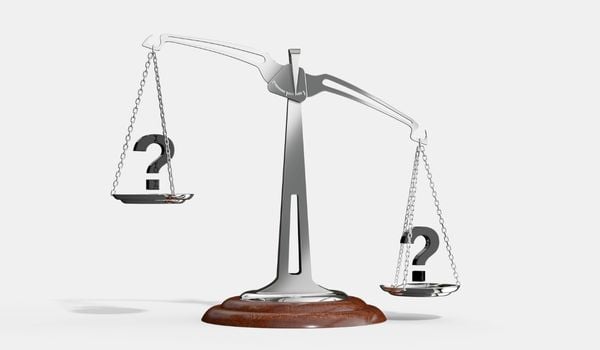
Pros:
- Crystal Clear Water: Embark on a journey to unparalleled water purity, ensuring every sip is refreshing and contaminant-free.
- Taste & Odor Improvement: Say bon voyage to unpleasant tastes and odors, as RO systems ensure your water is as pleasing to the palate as it is to the eye.
- Contaminant Removal: With an RO system on board, rest assured of a robust defense against a myriad of contaminants, safeguarding your health and wellbeing.
Cons:
- Water Waste: Some RO systems let water slip through the cracks, leading to higher water waste. Opt for systems designed for efficiency and sustainability.
- Initial Investment: Charting the course to pure water may demand an initial investment, but the bounty of pure water is worth its weight in gold.
- Maintenance: Keep your RO system shipshape with regular filter changes to ensure unyielding performance and water purity.
Key Considerations

Step 1: Gauge Your Water Needs
Analyze your household’s water consumption to choose an RO system with a suitable capacity and flow rate, ensuring a steady, uninterrupted supply of pure water.
Step 2: Contemplate Installation
Consider the installation demands of your chosen RO system. Opt for DIY-friendly designs or enlist professional installation to ensure a seamless setup.
Step 3: Mull Over Maintenance
Prioritize RO systems with straightforward, infrequent maintenance needs, ensuring your voyage to pure water remains unblemished by constant upkeep demands.
Before You Buy

Get the Most from Your RO System: Know What’s in Your Water
Before investing in a reverse osmosis system, it’s important to understand the specific contaminants in your water. This helps you choose a system that addresses your needs without paying for features you don’t require.
City Water Concerns: Even though city water is treated, it’s not always as clean as you’d hope. Despite passing through a treatment plant, your tap water might still have:
- Additives: Chlorine or chloramine, sometimes fluoride
- Leftover Chemicals: Things like pesticides, herbicides, or industrial chemicals
- Bits and Pieces: Sediment or traces of pharmaceuticals
- Surprise Guests: Lead, bacteria, or parasites from old pipes
Well Water Worries: If your water comes from a private well, you’re not dealing with city additives, but there are other things to watch out for. Studies show that about 1 in 5 wells could be contaminated with:
- Natural Stuff: Hard minerals, sediment, or even arsenic and mercury
- Chemicals: Nitrates from fertilizers or other chemicals from nearby industries
- Unwanted Organisms: Bacteria or other tiny critters that could make you sick
Pro Tip: The best way to choose they system is to know what’s in your water. City water users can get a quality report from their treatment authority but should test their tap water for lead separately. Well owners should do a comprehensive test — DIY or via a certified lab. Regardless of water source, you can then shop confidently for a filter that targets the greatest number of problem contaminants.
Cost Of Ownership
Owning an RO system involves more than just the initial purchase price. Consider the following ongoing costs:
- Filter Replacements: Depending on the system, filters need to be replaced every 6-12 months, and RO membranes typically last 2-3 years.
- Water Waste: Systems with higher water waste ratios may increase your utility bills, though modern RO systems are designed to be more efficient.
In a Nutshell:
In the quest for pristine water, an RO system is your steadfast ally, banishing contaminants and ensuring unrivaled water quality. But remember, every voyage demands preparation. Assess your needs, budget, and space, aligning them with your chosen RO system to ensure a seamless journey to unyielding water purity. Navigate wisely, and let the tide of pure, refreshing water flow incessantly in your home!
 94 people found this helpful. Was this guide helpful to you?
94 people found this helpful. Was this guide helpful to you? 
